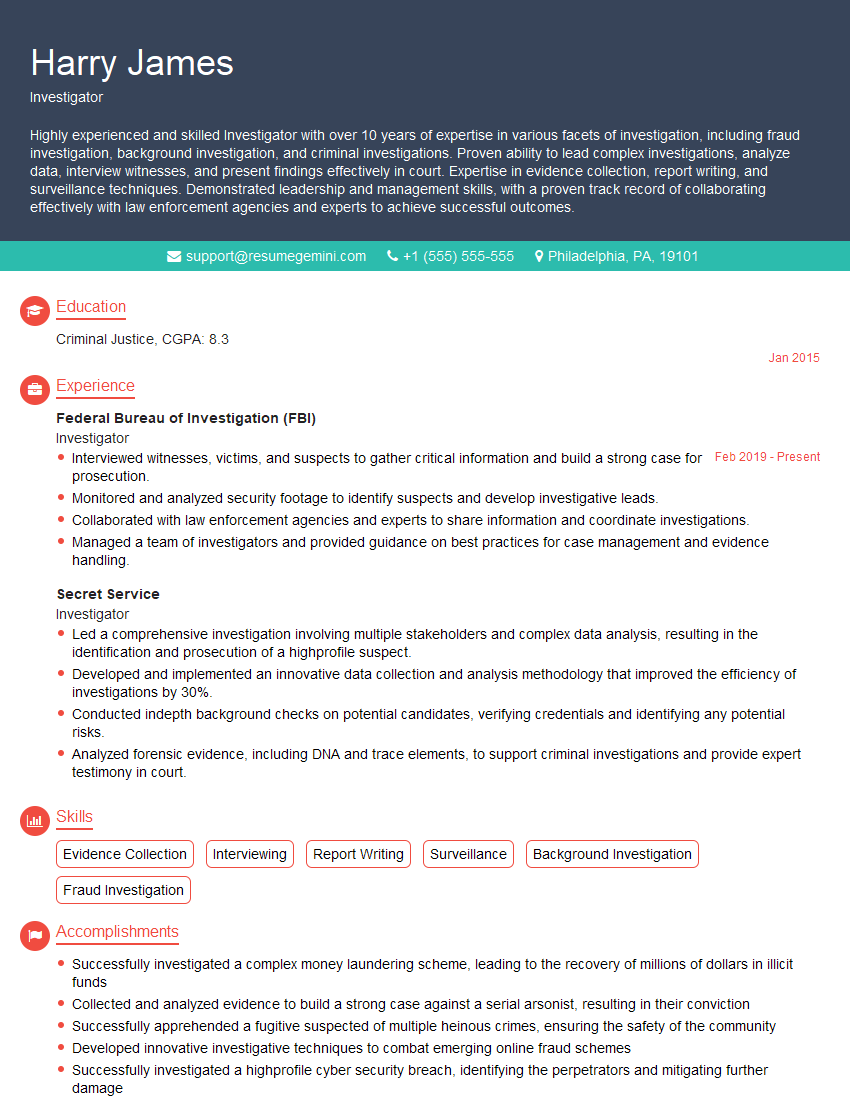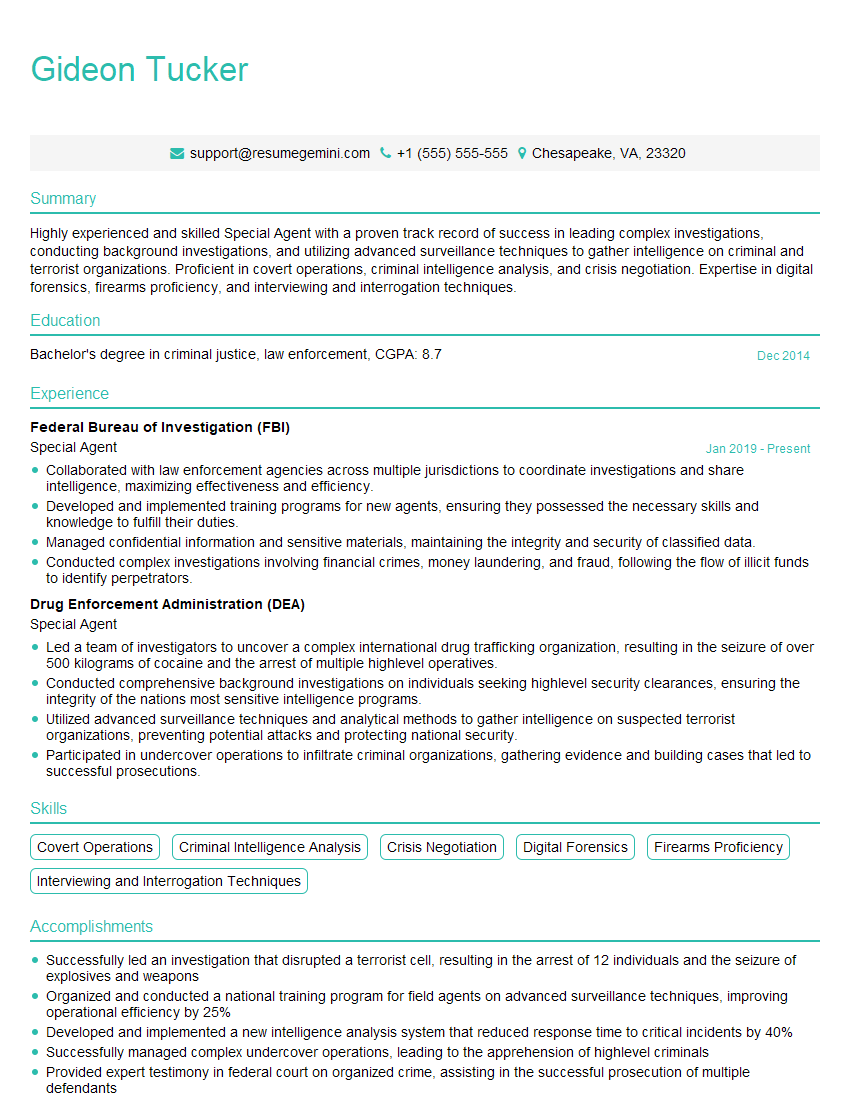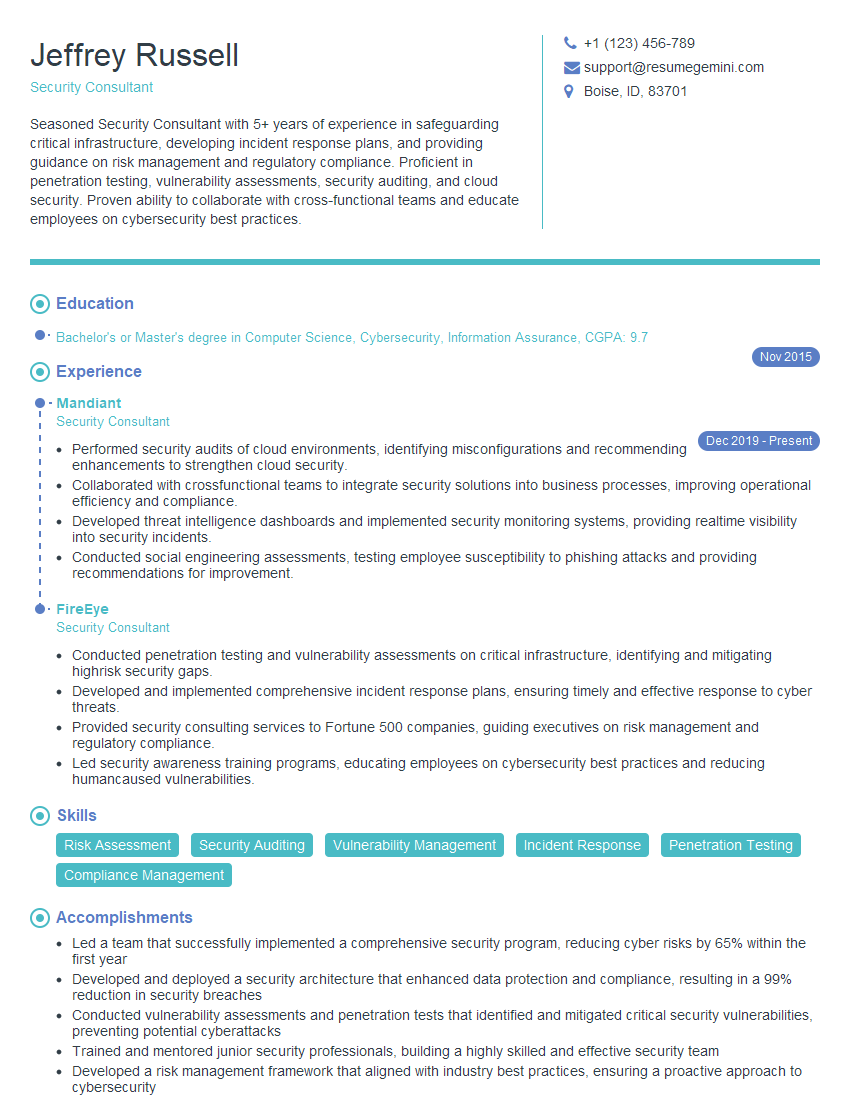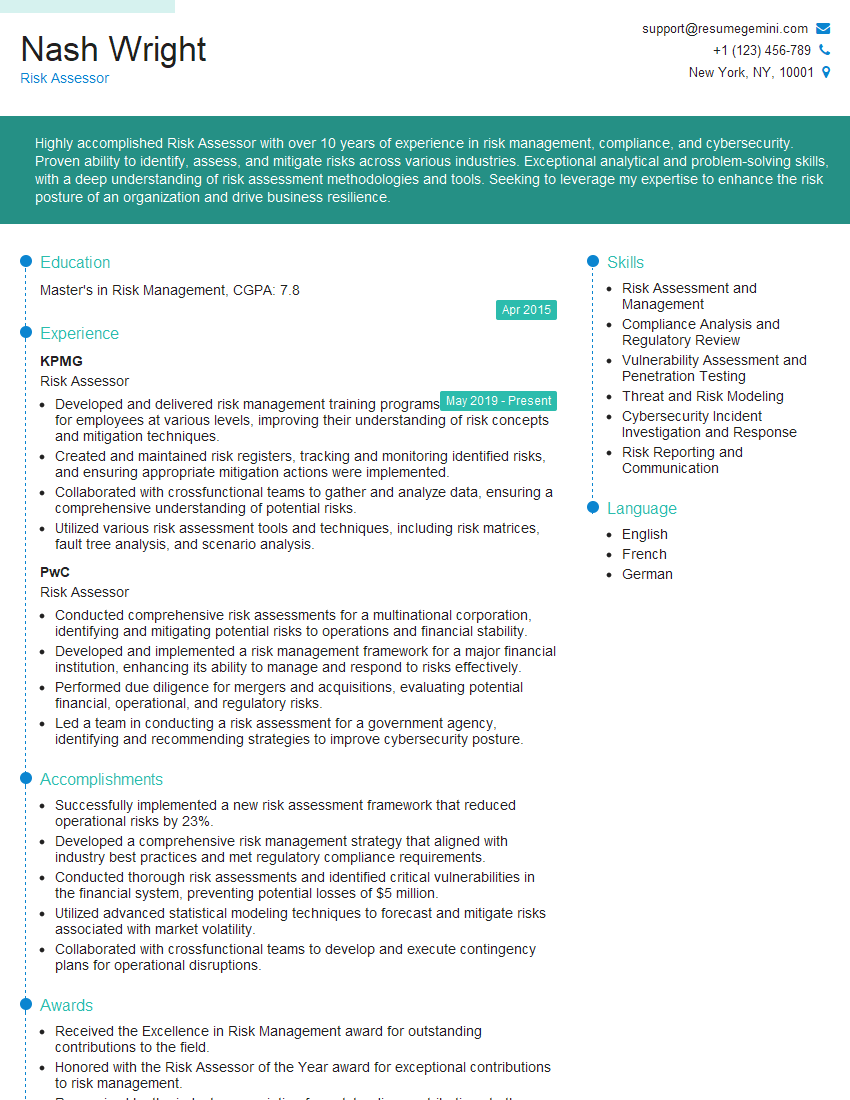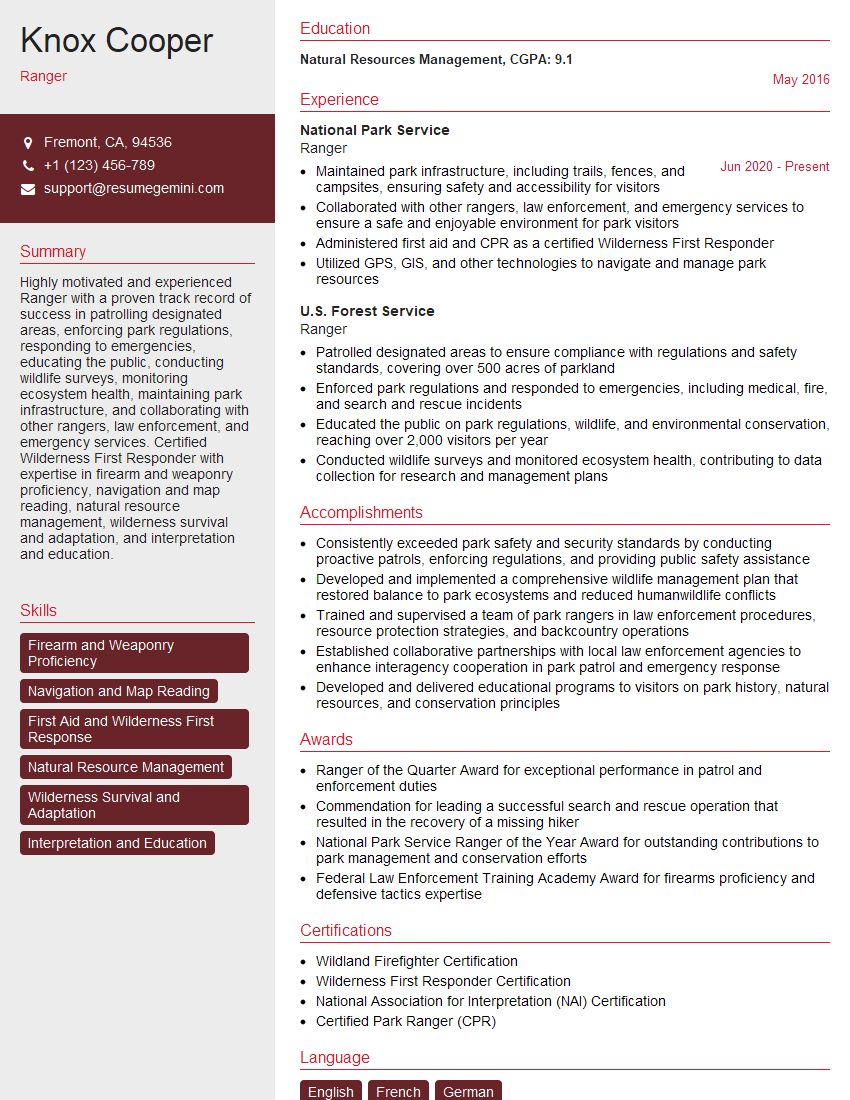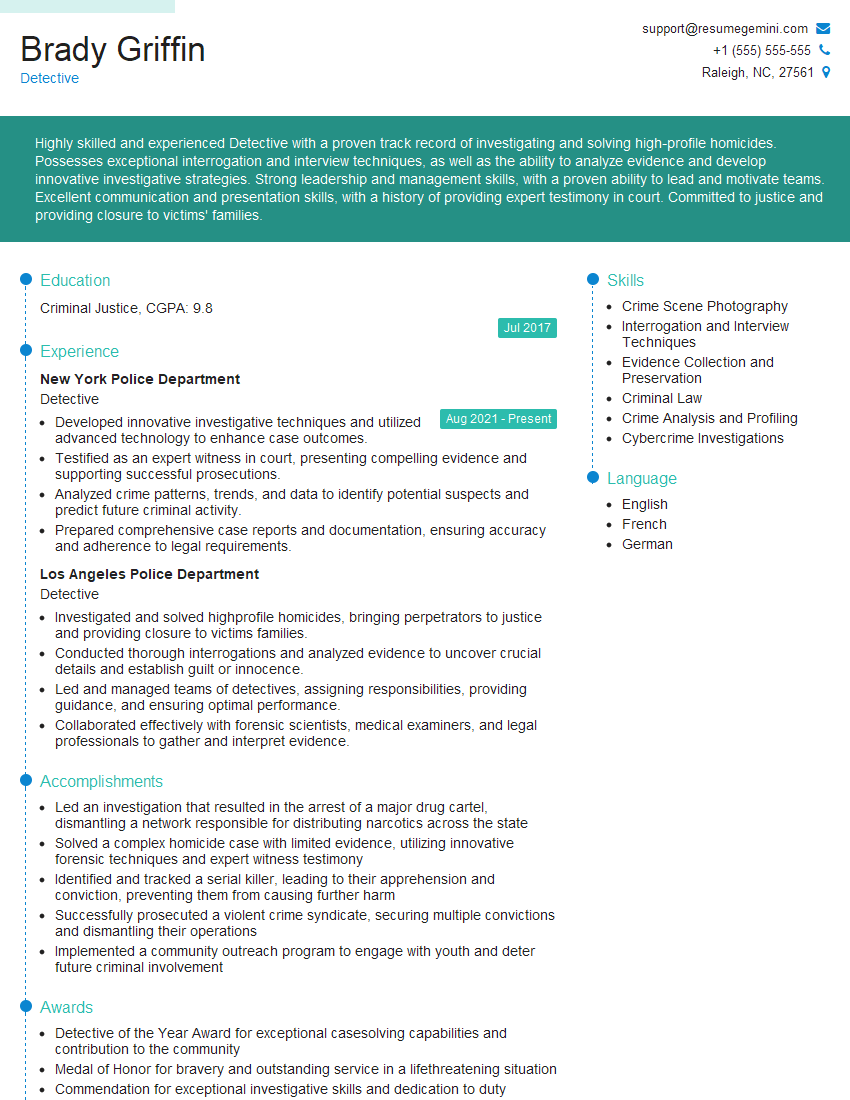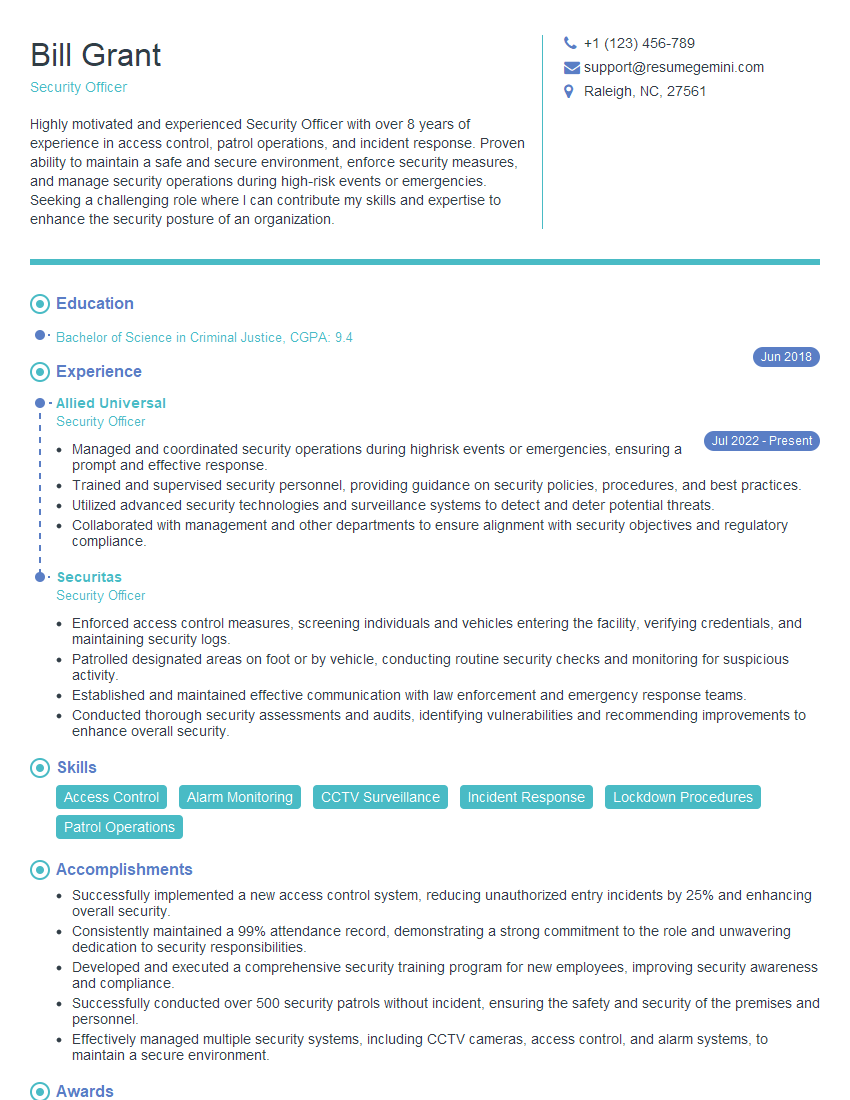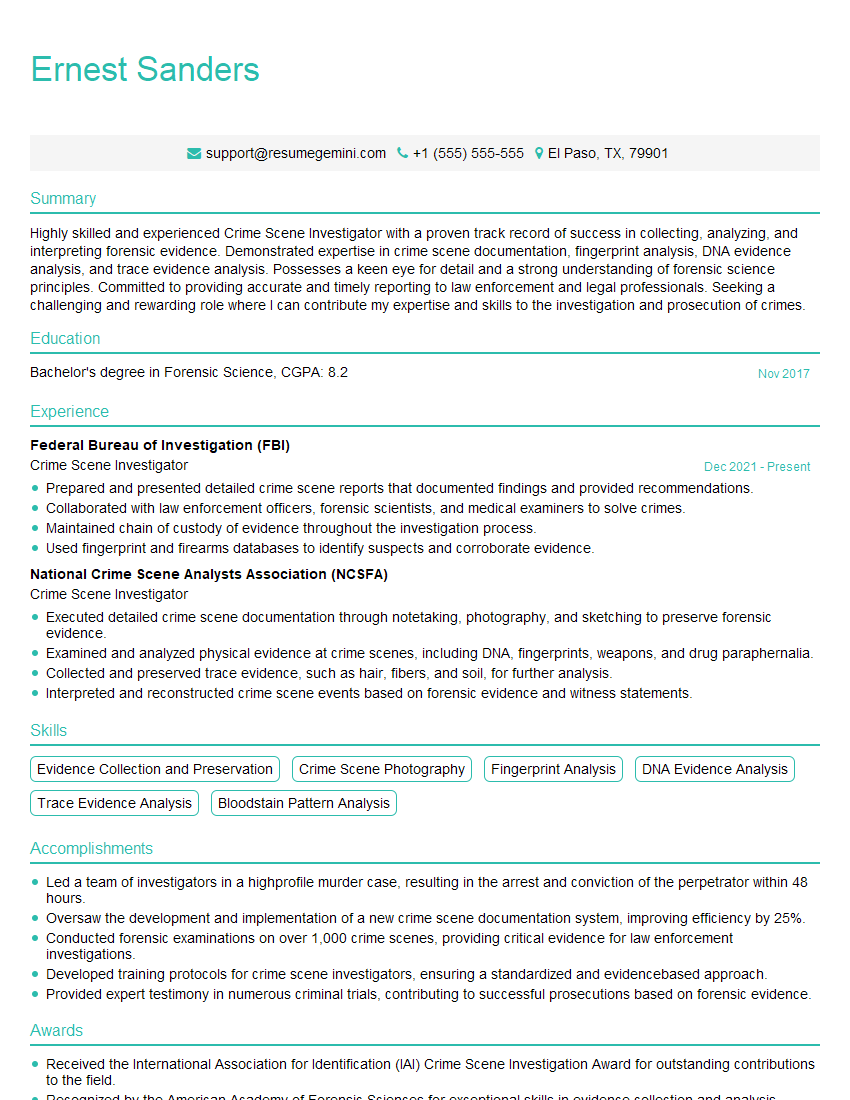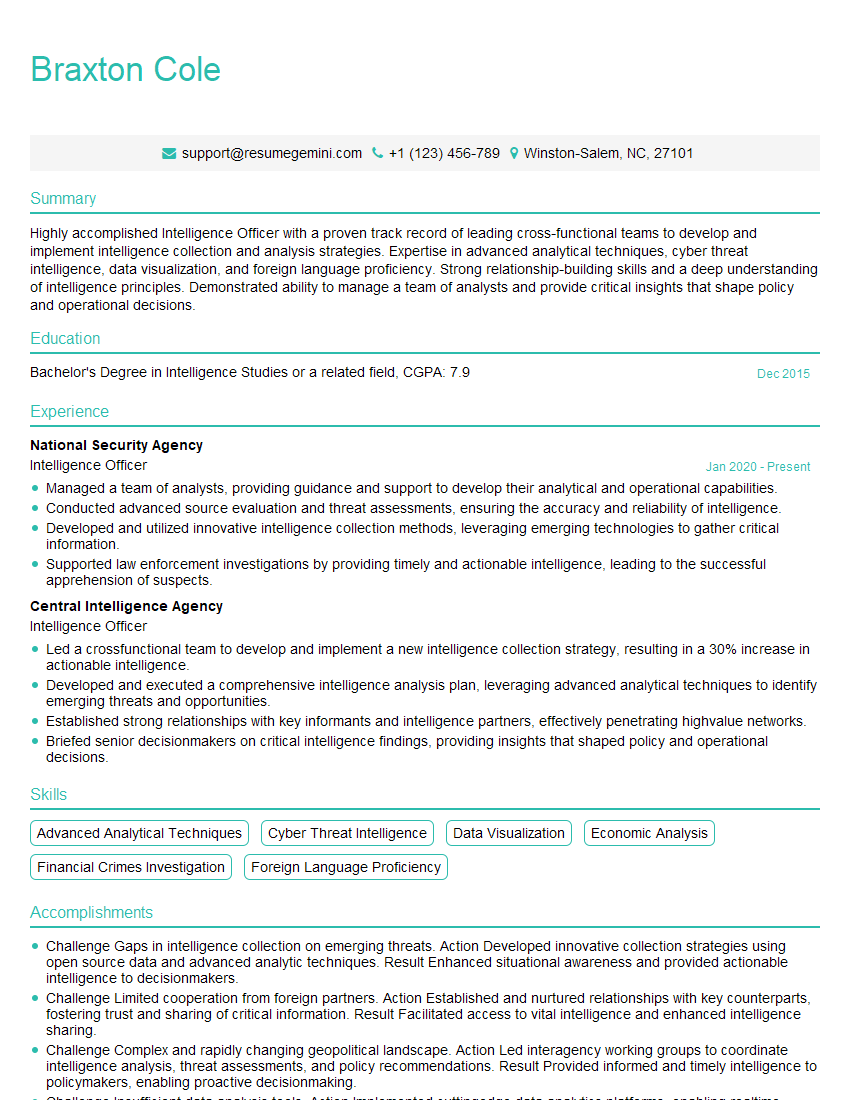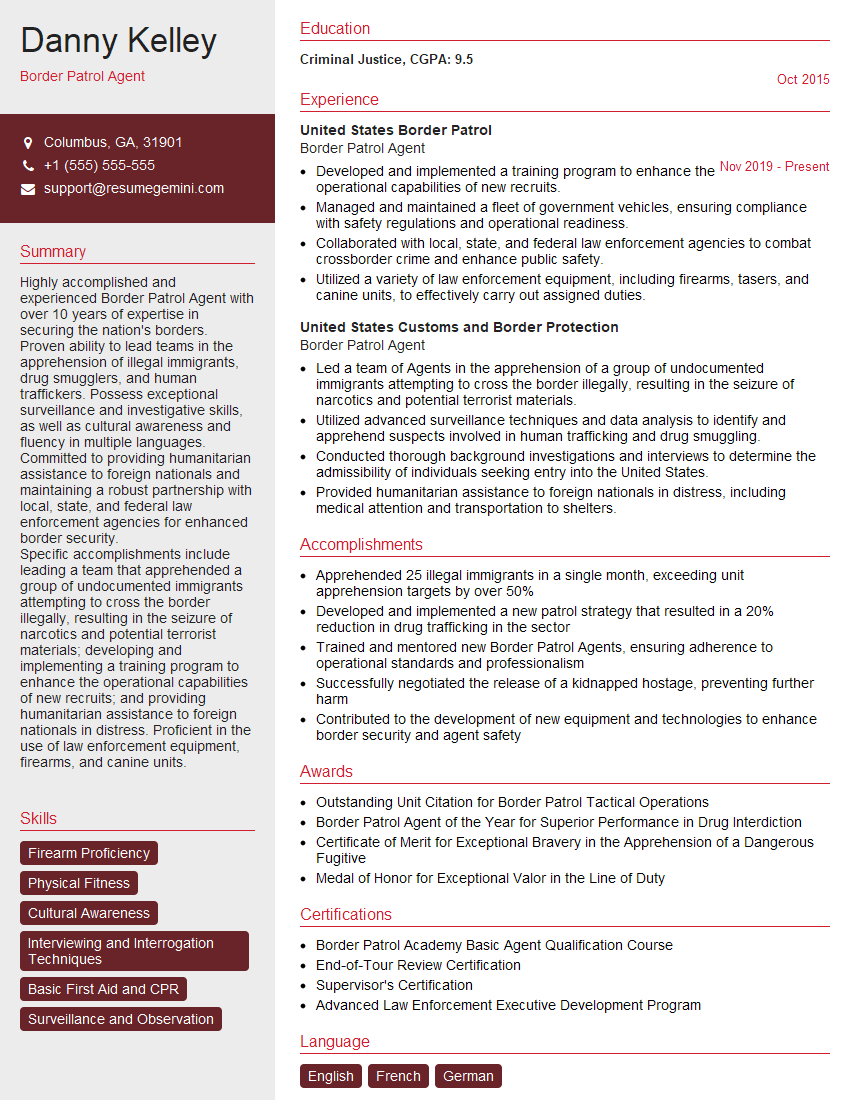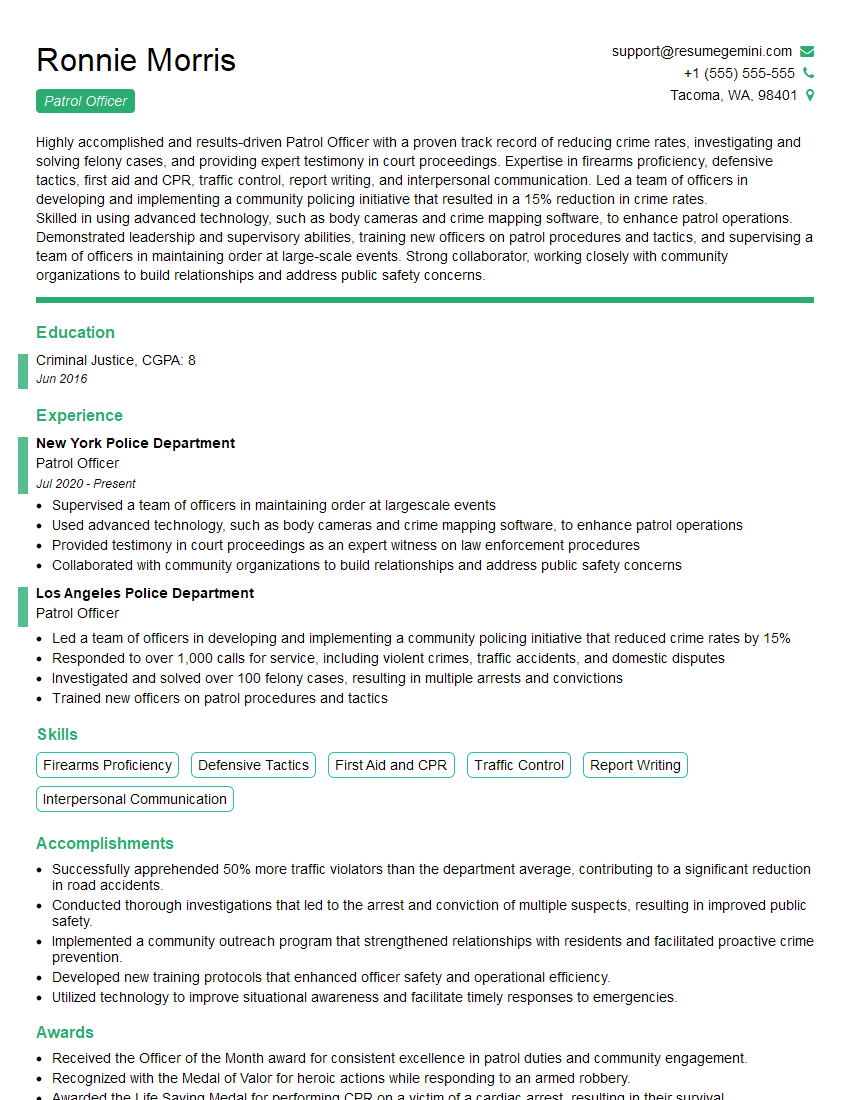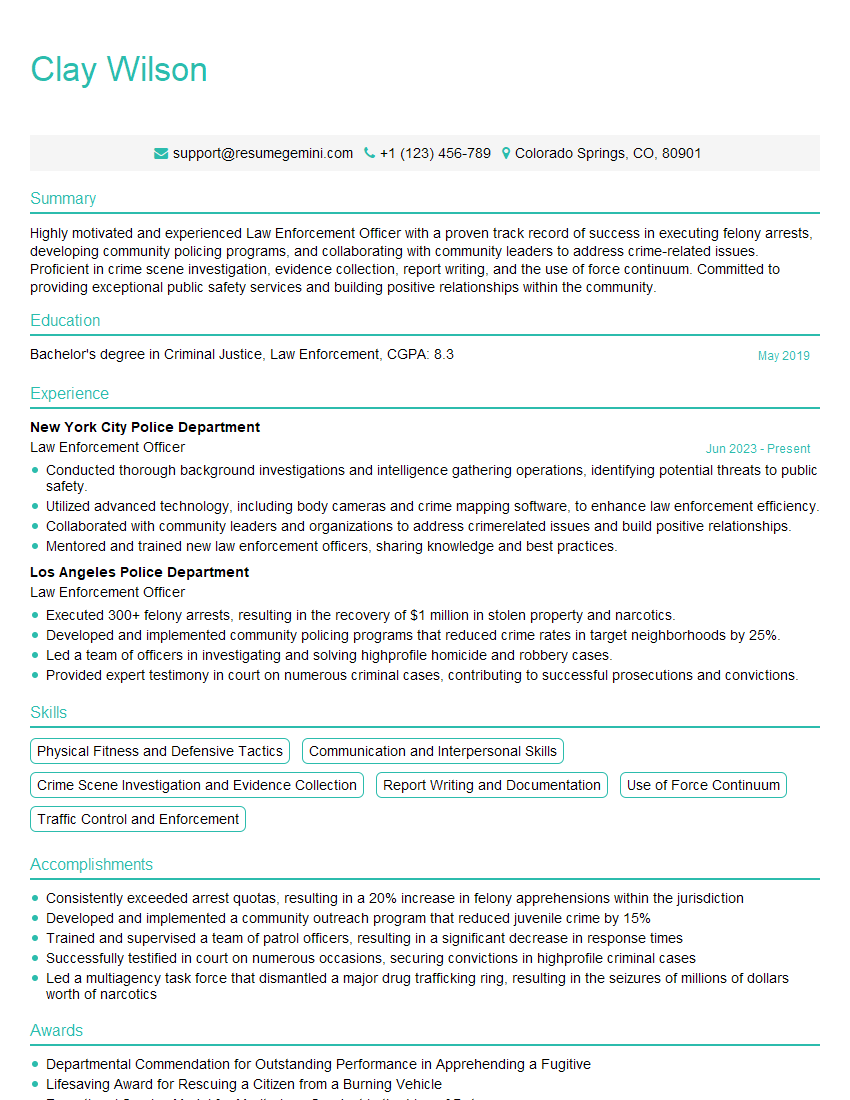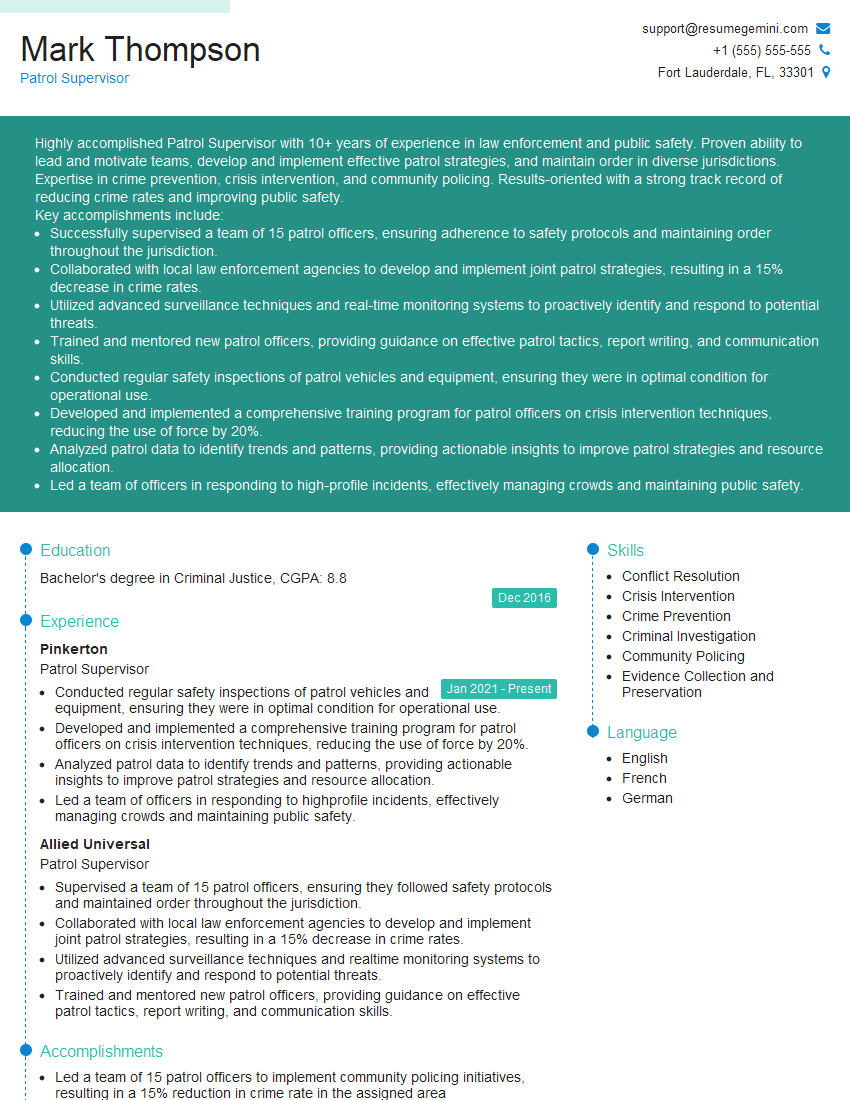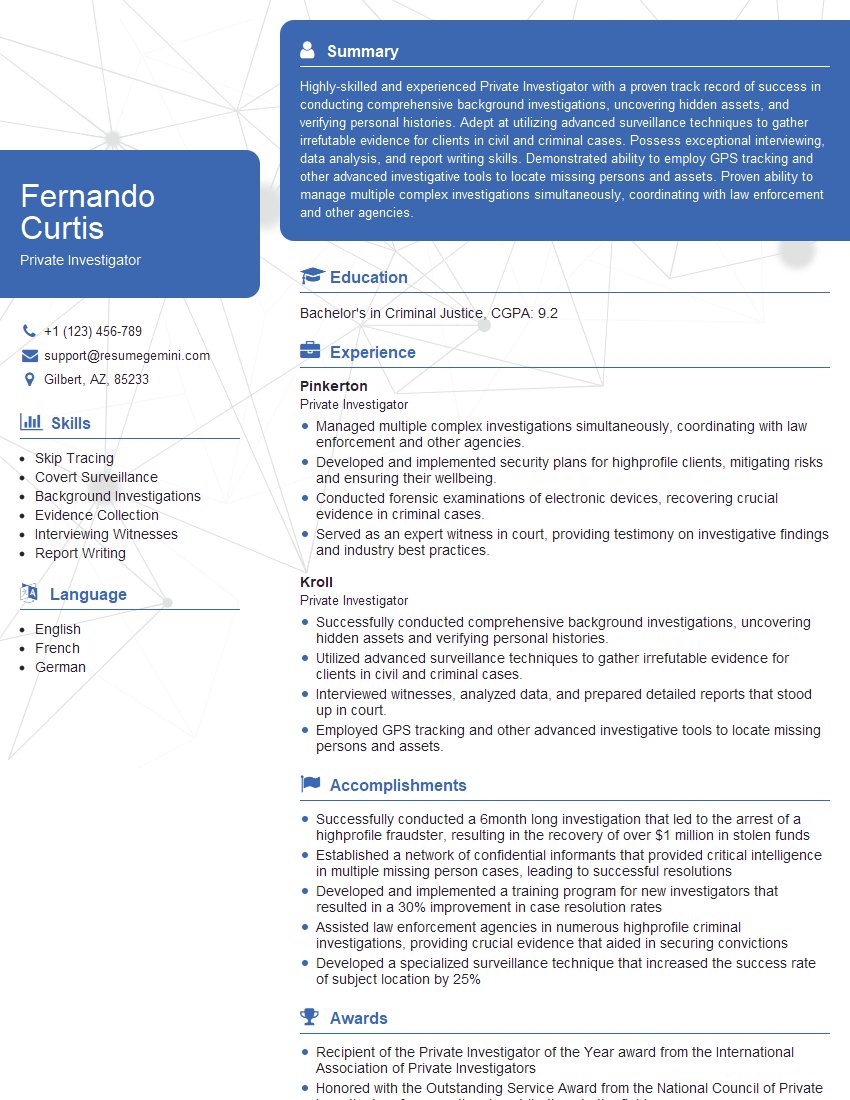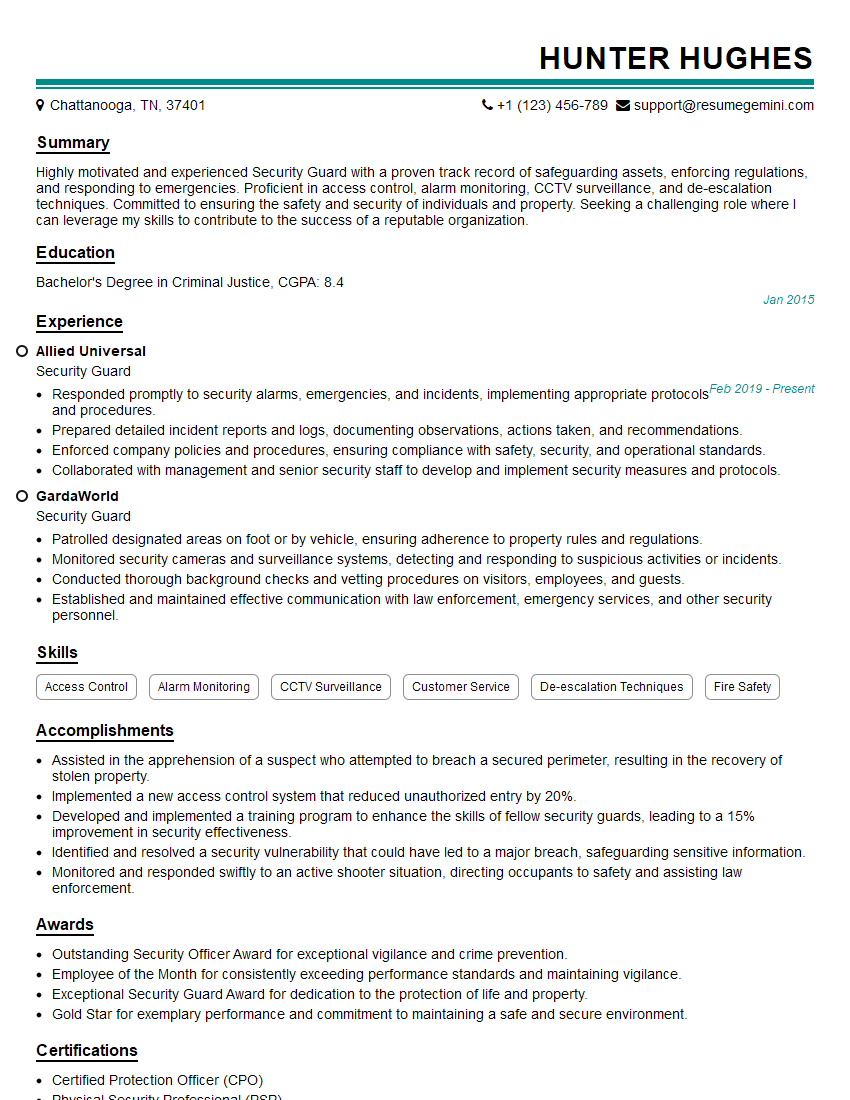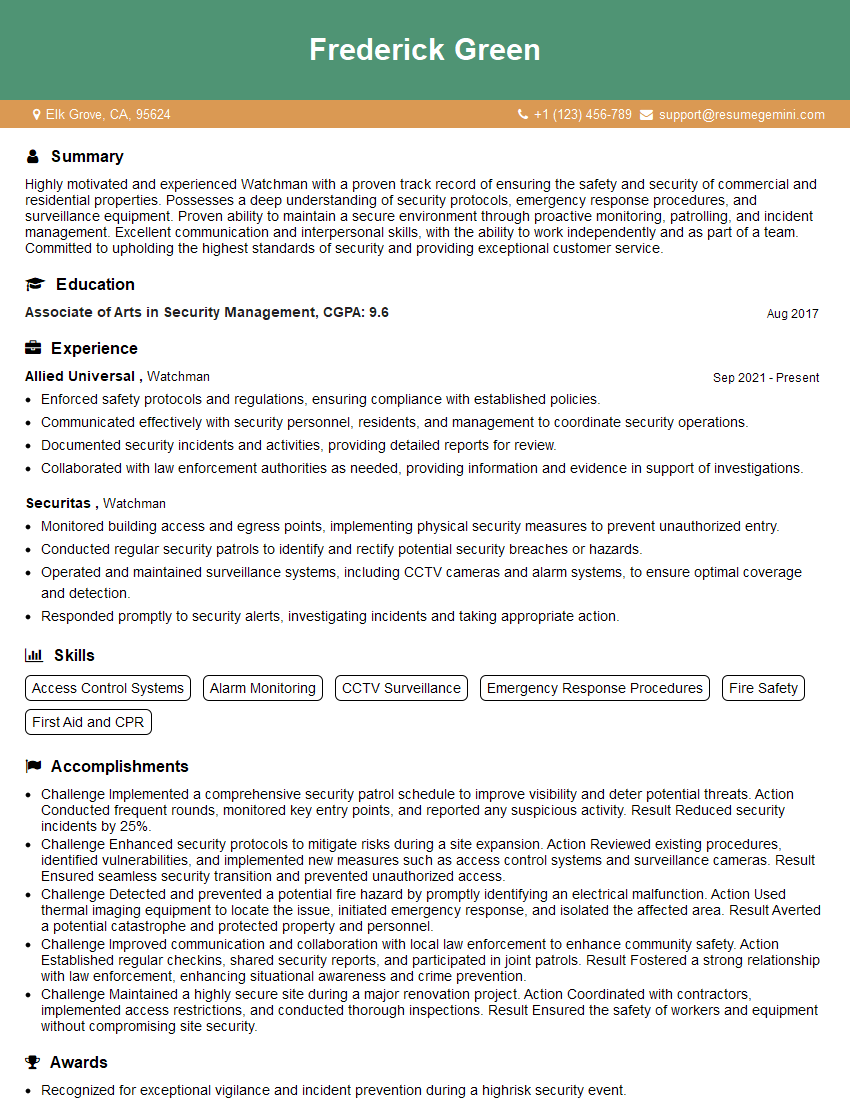Preparation is the key to success in any interview. In this post, we’ll explore crucial Patrol and Reconnaissance interview questions and equip you with strategies to craft impactful answers. Whether you’re a beginner or a pro, these tips will elevate your preparation.
Questions Asked in Patrol and Reconnaissance Interview
Q 1. Describe your experience in conducting area reconnaissance.
Area reconnaissance involves systematically observing and collecting information about a specific area to understand its terrain, features, and potential threats. It’s like creating a detailed map in your mind, not just of physical geography, but also of potential security concerns.
My experience includes leading and participating in numerous area reconnaissance missions, ranging from small-scale operations in urban environments to larger-scale missions in rugged terrain. For example, during a recent operation in a densely forested area, we used a combination of ground patrols and drone surveillance to map potential enemy positions, identifying choke points and likely ambush sites. This information was crucial in planning subsequent operations, allowing us to minimize risk and maximize effectiveness. We meticulously documented everything – from the types of vegetation and soil conditions to the presence of animal trails that might indicate human activity.
Q 2. Explain your understanding of patrol patterns and their effectiveness.
Patrol patterns are the predetermined routes and methods used to cover an area during a patrol. The effectiveness of a pattern depends heavily on the mission objective, terrain, and available resources. Think of it like mowing a lawn – you wouldn’t use the same pattern for a small, square lawn as you would for a large, irregular one.
- Linear Patrols: Covering a single route, suitable for patrolling a border or a linear feature like a pipeline. However, it’s predictable and may miss activity off the main route.
- Box Patrols: Covering a rectangular area by moving along the perimeter and checking the interior. Offers more comprehensive coverage than a linear patrol but can take longer.
- Circular Patrols: Rotating around a central point, effective for guarding a specific asset or location, but leaves areas outside the circle unchecked.
- Random Patrols: Unpredictable routes, designed to deter potential adversaries. Highly effective for security but requires more flexibility and coordination.
The choice of pattern is a tactical decision, often influenced by intelligence and risk assessment. During a past operation, we employed a combination of box and random patrols to secure a vital supply route, balancing the need for comprehensive coverage with the need to remain unpredictable.
Q 3. How do you prioritize security threats during a patrol?
Prioritizing security threats during a patrol involves a systematic risk assessment process. We use a combination of intelligence, situational awareness, and threat analysis to determine which threats pose the greatest immediate risk. This isn’t a random process; it’s a structured approach.
The process typically involves:
- Intelligence Gathering: Consolidating information from various sources – intelligence reports, local knowledge, and observations – to identify potential threats.
- Threat Assessment: Evaluating the likelihood and potential impact of each threat. A highly likely threat with high impact takes precedence.
- Resource Allocation: Allocating resources (personnel, equipment, time) based on the prioritization of threats. High-priority threats receive immediate attention.
- Dynamic Adaptation: Continuously reassessing threats based on new information and adjusting the patrol plan accordingly. This is crucial in unpredictable environments.
For example, if we receive intelligence suggesting a potential ambush along a particular route, that location automatically becomes a high-priority area, warranting increased vigilance and potentially altering our patrol pattern to avoid the threat.
Q 4. What are the different types of surveillance techniques you are familiar with?
Surveillance techniques vary depending on the objective, target, and environment. Some common methods include:
- Visual Surveillance: Direct observation, often from concealed positions or using binoculars. This is the most basic form but can be very effective.
- Electronic Surveillance: Utilizing technology like cameras, listening devices, or thermal imaging. This provides a level of detachment but is subject to technical failure and detection.
- Physical Surveillance: Following a target or maintaining a close proximity, often requiring specialized skills and training. This is resource-intensive and risky.
- Technical Surveillance: Using tools like GPS trackers and phone data monitoring. This requires a strong legal basis and appropriate authorization.
I am proficient in all these techniques and have experience adapting them to different situations. For instance, during one operation, we used a combination of visual surveillance from a concealed position and electronic surveillance via a strategically placed camera to monitor a suspected weapons cache, gathering vital evidence without compromising the safety of personnel.
Q 5. Describe your experience with report writing and documentation in patrol/reconnaissance.
Detailed and accurate report writing is crucial in patrol and reconnaissance. It forms the basis for future operations, intelligence gathering, and risk assessment. My reports are always structured, factual, and objective, following a standard format.
A typical report includes:
- Mission details: Objective, date, time, location, personnel involved.
- Observations: Detailed descriptions of terrain, activities, and any significant findings.
- Threats identified: Assessment of potential risks, including their nature, likelihood, and impact.
- Actions taken: A record of all actions performed during the patrol.
- Recommendations: Suggestions for future actions based on the findings.
I utilize various mapping tools and software to include accurate geographical information in my reports and ensure clarity through the use of maps, sketches, and photographs. Accuracy and completeness are paramount; incomplete or inaccurate reporting can have severe consequences.
Q 6. How do you handle unexpected situations or emergencies during patrol?
Handling unexpected situations during patrol requires swift thinking, decisive action, and adherence to established protocols. The key is to maintain situational awareness and respond appropriately to the specific challenge.
My approach involves:
- Assessment: Quickly assessing the nature and severity of the unexpected situation.
- Communication: Immediately communicating the situation to relevant personnel (command, support units).
- Action: Taking appropriate action based on the assessment and communication, prioritizing safety and mission objectives.
- Documentation: Thoroughly documenting the event, actions taken, and outcomes in the patrol report.
For instance, if we encounter a hostile encounter during a patrol, the team’s established procedures kick in immediately: we respond according to the rules of engagement, prioritize casualty evacuation, secure the scene, and update command. Following established protocols is critical in these high-pressure situations.
Q 7. What are your skills in using mapping and GPS technology for navigation and patrol planning?
I possess advanced skills in using mapping and GPS technology for navigation and patrol planning. This includes the use of various software applications such as ArcGIS, Google Earth, and specialized military mapping systems. My proficiency extends beyond simple navigation; I’m adept at using these tools to plan efficient patrol routes, identify optimal vantage points, and assess terrain challenges.
I can create detailed maps incorporating relevant information like terrain features, potential hazards, and points of interest. GPS technology is crucial for tracking the patrol’s progress, maintaining situational awareness, and recording precise locations of events or findings. For example, during a recent search-and-rescue operation, our ability to accurately pinpoint the location of the missing person using GPS and detailed mapping was instrumental in their successful rescue.
Q 8. Explain your knowledge of relevant laws and regulations pertaining to patrol and security.
My understanding of laws and regulations governing patrol and security is extensive. This includes a thorough grasp of laws related to use of force, search and seizure (understanding the Fourth Amendment implications), evidence collection and handling, and the legal boundaries of surveillance. For example, I’m familiar with the nuances of the varying degrees of force permissible under different circumstances, ensuring that actions remain within legal and ethical parameters. I also understand the importance of maintaining proper documentation and adhering to chain of command protocols when dealing with legal situations encountered during patrols.
Specifically, I’m knowledgeable about local, state, and potentially federal regulations depending on the operational environment. This includes understanding rules regarding the carrying of weapons, the use of restraint techniques, and reporting procedures for incidents. My training also emphasized understanding specific regulations regarding private property versus public spaces, ensuring that all actions are both lawful and appropriate to the situation.
Q 9. How do you maintain situational awareness during a patrol?
Maintaining situational awareness is paramount during patrol. It’s not just about what’s immediately in front of you, but a constant assessment of your surroundings, including the environment, people present, and potential threats. I achieve this through a combination of techniques:
- Active observation: Constantly scanning my surroundings, paying attention to details like unusual activity, suspicious vehicles, or individuals acting strangely. This includes employing techniques like scanning buildings, observing people’s body language, and taking note of things out of place.
- Predictive policing: Using knowledge of the area and historical data to anticipate potential problems. Knowing high-crime areas and common points of criminal activity allows for proactive measures.
- Communication: Regularly communicating with dispatch and other units, providing updates on my location and observations. This allows for real-time adjustments to patrol strategy.
- Listening: Paying attention to environmental cues such as sounds that might indicate trouble, such as shouting, breaking glass, or car alarms.
For instance, during a night patrol in a high-crime area, I would be especially vigilant for loitering individuals, dark figures or vehicles moving unexpectedly, and unusual sounds. This proactive awareness helps prevent incidents or enables swift responses if needed.
Q 10. How do you effectively communicate information gathered during reconnaissance?
Effective communication of reconnaissance information is crucial for successful operations. My approach involves a structured and clear method:
- Timeliness: Reporting information immediately, especially if it concerns immediate threats or urgent situations.
- Clarity: Using precise and concise language to relay information, avoiding ambiguity or jargon. This often includes employing standardized reporting formats.
- Accuracy: Ensuring that all observations are accurate and factual, avoiding speculation or assumptions.
- Completeness: Including all relevant details, such as location, time, individuals involved, and any observed evidence.
- Medium: Selecting the appropriate communication method, considering the urgency and sensitivity of the information. This might range from radio transmissions to written reports.
For example, after completing a reconnaissance mission, I might use a standardized report format detailing the observed security measures at a target location, including camera coverage, access points, and personnel presence, then communicate this to my team leader via a secure messaging system.
Q 11. Describe your experience using various communication devices during patrol.
My experience with various communication devices is extensive. I am proficient in using:
- Two-way radios: For immediate communication with dispatch and other patrol units, ensuring seamless coordination during emergencies or routine patrols. I am familiar with different radio frequencies and protocols, understanding how to communicate effectively in high-stress situations.
- Mobile data terminals (MDTs): For accessing real-time information such as wanted persons databases, crime reports, and traffic updates. This allows for proactive and informed decision-making during patrols.
- Secure messaging systems: For confidential communication, exchanging sensitive information or detailed reports with supervisors or other team members.
- Body-worn cameras: Recording interactions with suspects or citizens, providing crucial evidence and accountability. I understand the legal and ethical implications associated with their usage.
For example, in a situation involving a suspect fleeing on foot, I would use my two-way radio to immediately alert other units, giving them descriptions and location to coordinate an effective apprehension. Simultaneously, I’d utilize my MDT to access details on the suspect, such as known aliases and potential threats.
Q 12. How do you identify and assess potential risks and vulnerabilities?
Identifying and assessing risks and vulnerabilities involves a systematic approach. I use a combination of observation, analysis, and experience to pinpoint potential threats. This includes:
- Environmental assessment: Identifying physical vulnerabilities such as poorly lit areas, unguarded access points, or weak infrastructure.
- Social assessment: Recognizing potential risks related to people, such as known troublemakers, gang activity, or areas prone to social unrest.
- Threat assessment: Evaluating the likelihood and potential impact of various threats, considering factors like time of day, location, and recent incidents.
- Vulnerability assessment: Identifying weaknesses that could be exploited by criminals, like unlocked doors, inadequate surveillance, or lack of security personnel.
For example, while patrolling a shopping center at night, I would note that the rear entrance is poorly lit and lacks surveillance cameras, representing a potential vulnerability for burglaries. I would then communicate this observation to appropriate management for preventative measures.
Q 13. Explain your proficiency in utilizing different patrol vehicles or equipment.
My proficiency with patrol vehicles and equipment is comprehensive. I am experienced in operating various vehicles such as:
- Patrol cars: Proficient in safe and efficient driving, including emergency driving techniques and pursuit procedures, always adhering to established protocols and ensuring public safety.
- All-terrain vehicles (ATVs): In appropriate terrains, navigating challenging environments while maintaining situational awareness. I understand the safety considerations and limitations of such vehicles.
- Marine vessels: Operating boats in various water conditions and understanding navigational rules.
Beyond vehicles, I am adept at using various equipment, including:
- Handheld radios and communication devices:
- Personal protective equipment (PPE): Proper and safe use of body armor, helmets, and other safety gear.
- Non-lethal weapons: Trained in the safe and effective application of tasers, pepper spray, and other less-than-lethal force options.
For example, during a search-and-rescue operation in a wooded area, my proficiency with an ATV would be crucial for navigating difficult terrain quickly and safely, while maintaining communication via handheld radio.
Q 14. Describe your experience working independently and as part of a team during patrols.
My experience working independently and as part of a team is extensive. I excel in both environments, adapting my approach based on the specific operational needs.
Independent patrols require strong self-discipline, initiative, and a high degree of situational awareness. I’m adept at managing my time, prioritizing tasks, and making independent decisions within established protocols. I’ve proven capable of handling various situations solo, while maintaining safety and effectively completing assigned tasks.
Teamwork involves effective communication, coordination, and collaboration. I’m a strong team player, comfortable contributing my expertise, actively listening to others’ perspectives, and working cohesively towards shared objectives. I value a collaborative approach, understanding that collective strength maximizes efficiency and safety, particularly in high-risk situations. I’ve participated in numerous team operations where efficient communication and coordination were essential to successful outcomes.
Whether working independently or as part of a team, my core values of safety, professionalism, and adherence to protocol remain unchanged. I prioritize achieving mission objectives while ensuring the safety of myself and others involved.
Q 15. How do you ensure the safety and security of yourself and others during patrol operations?
Safety and security during patrol operations are paramount. It’s a layered approach, starting with meticulous planning. This includes thorough route familiarization, understanding potential threats specific to the area, and having clear communication protocols established with a command center or backup team.
On the ground, situational awareness is crucial. This means constantly scanning my surroundings, paying attention to unusual activity or individuals, and maintaining a safe distance from potential hazards. I always maintain visual contact with my patrol partner, ensuring we cover each other’s six.
My equipment plays a significant role: a high-visibility vest, personal protective equipment (PPE) appropriate for the environment, and readily accessible communication devices are essential. Regular training in defensive tactics, first aid, and emergency response procedures ensures I’m prepared for unforeseen circumstances. Finally, I adhere strictly to all safety regulations and procedures established by my organization.
For example, during a night patrol in a high-crime area, we’d adjust our patrol pattern to utilize well-lit streets, maintain radio contact at all times, and avoid isolated locations. We’d also be especially alert for signs of suspicious activity like loitering or vandalism.
Career Expert Tips:
- Ace those interviews! Prepare effectively by reviewing the Top 50 Most Common Interview Questions on ResumeGemini.
- Navigate your job search with confidence! Explore a wide range of Career Tips on ResumeGemini. Learn about common challenges and recommendations to overcome them.
- Craft the perfect resume! Master the Art of Resume Writing with ResumeGemini’s guide. Showcase your unique qualifications and achievements effectively.
- Don’t miss out on holiday savings! Build your dream resume with ResumeGemini’s ATS optimized templates.
Q 16. What are your skills in observation and detail-oriented reporting?
Observation and detailed reporting are foundational skills in patrol and reconnaissance. My training emphasized developing keen observational abilities, focusing on both visual and auditory details. I’m adept at identifying subtle anomalies in a scene – something out of place, unusual behavior, or a change in a known pattern.
My reporting is concise, accurate, and objective. I use a structured format to document my observations, including timestamps, location details, descriptions of individuals or events, and any evidence collected. I prioritize clarity to ensure accurate information transfer to other personnel or agencies.
For instance, instead of writing “suspicious activity,” I might detail: “At 22:15, three individuals observed loitering near the abandoned building at 14 Oak Street. One individual was wearing a dark hooded sweatshirt; another carried a large duffel bag. They appeared nervous and frequently looked over their shoulders.” This level of detail is critical for effective investigation and response.
Q 17. Explain your understanding of different patrol methods (e.g., foot patrol, vehicle patrol).
Patrol methods vary depending on the environment, mission objectives, and available resources. Foot patrols allow for close interaction with the community, enabling officers to build rapport and identify potential problems early on. They are particularly effective in dense urban areas or areas with limited vehicle access.
Vehicle patrols cover larger areas more quickly and provide mobility advantages. They’re useful for rapid response to incidents and covering large geographical areas. Bicycle patrols offer a balance, combining the maneuverability of foot patrol with greater coverage area.
Other methods include mounted patrols (horseback), marine patrols (boats), and air patrols (helicopters or drones). Each method has strengths and weaknesses and is chosen based on specific operational needs. For example, a rural area might be best suited for vehicle patrols, while a large public event might necessitate foot patrols supplemented by vehicle and possibly mounted patrols for crowd control.
Q 18. How do you manage stress and fatigue during extended patrols?
Extended patrols often lead to stress and fatigue, which can impair judgment and reaction times. I address this through a combination of strategies. Firstly, maintaining physical fitness is essential. Regular exercise improves stamina and resilience to stress.
Secondly, proper hydration and nutrition are crucial. Dehydration and lack of proper fuel can exacerbate fatigue and stress. I always carry adequate water and high-energy snacks. Thirdly, effective sleep management is vital. I prioritize getting enough sleep before a patrol and take short breaks when possible during long shifts to rest and refocus.
Finally, mental resilience is equally important. Techniques like mindfulness or deep breathing exercises can help manage stress in the moment. Regular debriefing sessions with colleagues also help to process experiences and prevent burnout. During particularly challenging patrols, I might use short meditation techniques to center myself and maintain alertness.
Q 19. Describe your experience in dealing with hostile or aggressive individuals during patrol.
Dealing with hostile or aggressive individuals requires a calm and controlled approach. De-escalation is the primary goal. This involves using verbal communication techniques to calm the individual, showing empathy, and actively listening. I maintain a non-threatening posture and avoid escalating the situation with aggressive body language or confrontational language.
If de-escalation fails, I follow established protocols for conflict resolution, prioritizing the safety of myself, the public, and the individual. This may involve calling for backup, using appropriate force if necessary (always within the bounds of the law and organizational policy), and ensuring the safety of everyone involved.
In one instance, I encountered an intoxicated individual behaving aggressively towards passersby. Through calm communication and creating a safe space, I was able to de-escalate the situation without the need for physical intervention. The individual calmed down, apologized for his behavior, and was then escorted to a place of safety.
Q 20. How do you utilize technology (e.g., body cameras, drones) to enhance patrol effectiveness?
Technology significantly enhances patrol effectiveness. Body cameras provide irrefutable evidence of events, increasing accountability and transparency. They also act as a deterrent against misconduct and can be crucial in resolving disputes.
Drones offer aerial surveillance capabilities, allowing for wider area coverage and identification of potential threats or hazards from a safe distance. They can be especially useful in search and rescue operations or in situations where ground access is limited.
Other technologies include GPS tracking systems for monitoring patrol routes and response times, and specialized software for data analysis and reporting. The strategic use of these technologies optimizes resource allocation, improves situational awareness, and enhances the overall effectiveness of patrol operations. For example, drone footage can be used to quickly assess a situation during a large-scale event or provide visual evidence for a crime scene investigation.
Q 21. How do you maintain confidentiality and data security when handling sensitive information gathered during patrols?
Confidentiality and data security are critical when handling sensitive information gathered during patrols. I adhere strictly to all organizational policies and legal regulations concerning the handling of sensitive information.
This includes secure storage of physical and digital records, using encrypted communication channels, and limiting access to information on a need-to-know basis. I am also trained on data breach procedures and know how to report any suspected security incidents immediately.
For example, all reports containing personal identifying information are handled according to strict privacy protocols. Access is restricted to authorized personnel only and all digital records are encrypted using robust algorithms. The importance of data protection cannot be overstated, protecting both the individual’s privacy and the integrity of our operations.
Q 22. Explain your understanding of emergency response procedures during patrol.
Emergency response during patrol hinges on swift, decisive action and adherence to established protocols. It’s not just about reacting; it’s about proactive risk assessment and preparedness. My approach prioritizes the safety of both myself and the public.
My understanding involves:
- Immediate Assessment: The first step is rapidly assessing the situation – identifying the nature of the emergency, the level of threat, and the number of casualties (if any). This informs the urgency and scale of the response.
- Prioritization: Based on the assessment, I prioritize actions. Is it a life-threatening situation requiring immediate medical attention? Is it a security breach demanding immediate containment? This prioritization is crucial in time-sensitive scenarios.
- Communication: Effective communication is paramount. I would immediately contact dispatch, relaying precise details of the situation including location, nature of the emergency, and any initial observations. Clear communication minimizes confusion and maximizes the effectiveness of backup resources.
- Action & Control: Following the initial assessment and communication, I take immediate action within my capabilities and training to mitigate the threat or alleviate suffering. This might involve providing first aid, securing a scene, or coordinating with other emergency responders.
- Post-Incident Procedures: Once the immediate crisis is under control, I follow standard post-incident procedures, including securing evidence, documenting the event, and submitting reports to relevant authorities. This ensures accountability and contributes to future preparedness.
For example, if I encountered a car accident during patrol, I’d first secure the scene, assess injuries, provide basic first aid if qualified, call emergency medical services, direct traffic to prevent further accidents, and then document the incident and take witness statements.
Q 23. How do you conduct a thorough building search or security sweep?
A thorough building search, or security sweep, requires methodical planning and execution to ensure complete coverage and the identification of any potential threats or vulnerabilities. It’s not simply a walk-through; it’s a systematic process demanding attention to detail.
My procedure typically follows this structure:
- Planning & Briefing: Before commencing, I would gather information about the building’s layout (blueprints are helpful), potential hazards (known or suspected), and any specific objectives for the search.
- Teamwork (if applicable): If working as part of a team, I’d establish clear roles and communication protocols, such as using hand signals to minimize noise and maintain situational awareness.
- Systematic Search Pattern: I would employ a systematic search pattern, such as the ‘clock method’ (starting at one point and systematically moving clockwise), the ‘crisscross’ method, or a ‘grid’ search, to ensure complete coverage. No area should be missed.
- Careful Observation: Each room and area would be carefully examined. I’d look for anything unusual, out of place, or potentially suspicious – open doors, forced entries, suspicious devices, or anything that deviates from the expected norm.
- Documentation: During and after the search, thorough documentation is essential. This includes noting unusual findings, taking photographs (if appropriate and permitted), and recording the locations of any evidence or items of interest.
- Safety Precautions: Throughout the search, safety is paramount. This involves being aware of potential hazards, utilizing appropriate protective equipment (if required), and maintaining tactical awareness of one’s surroundings.
Imagine searching an office building after hours. I’d start by checking the perimeter, then follow a methodical approach, room by room, floor by floor, using a flashlight, and carefully checking closets, drawers, and under furniture.
Q 24. Describe your experience in conducting covert surveillance operations.
Covert surveillance demands patience, meticulous planning, and a deep understanding of observation techniques and counter-surveillance measures. It’s about gathering intelligence without being detected.
My experience involves:
- Surveillance Planning: This involves defining the objectives, identifying the target, and selecting appropriate surveillance methods (e.g., visual surveillance, electronic surveillance, or a combination).
- Maintaining Cover: Maintaining a low profile is crucial. This requires blending in with the environment, avoiding patterns that might draw attention, and using appropriate concealment methods. I’ve learned the importance of adopting inconspicuous behaviors and avoiding anything that looks out of place.
- Observation & Documentation: Careful observation is crucial. This includes detailed note-taking (using coded language if necessary) of the target’s activities, associates, and locations. Photographs or video recordings can provide valuable evidence. It’s important to maintain a clear and detailed record.
- Risk Assessment & Mitigation: Covert surveillance always involves inherent risks. I would develop contingency plans to manage these risks (e.g., if discovered) including escape routes and cover stories.
- Legal and Ethical Considerations: Covert operations must adhere strictly to legal and ethical guidelines. Prior approval and legal authorization are crucial and must be obtained before initiating any surveillance activity.
One scenario involved monitoring a suspected individual’s activities to gather evidence for a criminal investigation. I needed to maintain a safe distance, avoid drawing attention, and carefully document the target’s movements and interactions.
Q 25. How do you adapt your patrol strategies based on changing environmental conditions or threats?
Adaptability is essential in patrol. Environmental conditions and emerging threats require flexible strategies. Rigidity can be dangerous.
My approach involves:
- Environmental Awareness: I constantly assess the environment – weather conditions (rain, snow, extreme temperatures), terrain (rough terrain necessitates different vehicle choices), and lighting. These factors influence visibility, mobility, and potential risks.
- Threat Assessment: The threat landscape is constantly evolving. I stay updated on intelligence reports, and adjust patrol routes and strategies based on any evolving risks. For example, if there’s an increase in crime in a certain area, I’d increase patrols and adjust my approach.
- Resource Management: I adjust my patrol strategies based on available resources. If a particular area requires a more intense patrol, I’d allocate more time and/or personnel to it.
- Communication & Coordination: In high-risk situations or during unexpected events, I ensure constant communication with colleagues and dispatch to share information and coordinate responses. The aim is always to maximize safety and effectiveness.
For example, during a severe thunderstorm, I would shift to less exposed areas, limit my outdoor activities, and prioritize ensuring the safety of the public and myself.
Q 26. What are your skills in first aid and emergency medical response?
I possess advanced first aid and emergency medical response skills. My certifications include [List specific certifications, e.g., Advanced First Aid, CPR/AED, etc.]. I am trained in basic life support and can effectively administer first aid in a variety of situations, from minor injuries to more serious emergencies. My training extends to stabilizing patients until professional medical help arrives.
This includes skills such as:
- Wound care
- Bleeding control
- Shock management
- CPR and AED use
- Immobilization of fractures
- Assessment of injuries and triage
I understand the importance of proper documentation of any first aid rendered, ensuring a complete record is maintained for future reference.
Q 27. How do you handle difficult or complex situations requiring quick decision-making during patrol?
Handling complex situations during patrol demands quick thinking, sound judgment, and a systematic approach. Panicking is not an option.
My approach is based on:
- Calm Assessment: I remain calm under pressure, focusing on systematically assessing the situation. This includes identifying the key elements, the immediate risks, and the available resources.
- Prioritize Actions: I prioritize actions based on the level of urgency. Is there an immediate threat to life? Does the situation require immediate intervention, or can it wait for backup?
- Communication: I maintain clear and concise communication with dispatch and any other relevant personnel. This ensures that backup and other necessary resources can be promptly deployed.
- Decision-Making Framework: I follow a decision-making framework that considers the legal, ethical, and tactical implications of each option. This includes considering the potential consequences of each course of action and selecting the best one based on available information. This may involve carefully considering the use of force and adhering to strict legal guidelines.
- Debriefing: After the incident, I conduct a thorough debriefing, examining my actions and identifying areas for improvement. This is crucial for continuous learning and development.
For example, encountering an active shooter situation would necessitate immediate action to secure the scene, prioritize evacuation of civilians, and work in coordination with responding law enforcement.
Key Topics to Learn for Patrol and Reconnaissance Interview
- Patrol Planning & Execution: Understanding mission objectives, route planning, risk assessment, and effective team communication during patrol operations.
- Reconnaissance Techniques: Mastering observation skills, utilizing various reconnaissance methods (e.g., visual, electronic), data collection and analysis, and reporting procedures.
- Terrain Analysis & Navigation: Interpreting maps and aerial imagery, utilizing compass and GPS, navigating challenging terrain, and understanding the impact of environmental factors on operations.
- Situational Awareness & Threat Assessment: Developing keen observation skills, identifying potential threats, assessing risk levels, and implementing appropriate security measures.
- Communication & Reporting: Utilizing effective communication protocols, accurately reporting findings and observations, and maintaining secure communication channels.
- Emergency Procedures & Response: Understanding and implementing emergency protocols, first aid and self-defense techniques, and procedures for handling unexpected situations.
- Teamwork & Leadership: Demonstrating effective teamwork skills, leadership qualities in diverse situations, and the ability to motivate and manage team members under pressure.
- Legal and Ethical Considerations: Understanding the legal framework governing patrol and reconnaissance operations, maintaining ethical standards, and respecting human rights.
Next Steps
Mastering Patrol and Reconnaissance skills opens doors to exciting and impactful career opportunities, offering challenges and growth within the field. To maximize your job prospects, it’s crucial to present your qualifications effectively. Building an ATS-friendly resume is essential for getting your application noticed by recruiters. ResumeGemini can help you create a professional and impactful resume tailored to highlight your skills and experience in Patrol and Reconnaissance. We provide examples of resumes specifically crafted for this field to help guide you. Invest time in crafting a compelling resume – it’s your first impression and a key to unlocking your career aspirations.
Explore more articles
Users Rating of Our Blogs
Share Your Experience
We value your feedback! Please rate our content and share your thoughts (optional).
What Readers Say About Our Blog
Hello,
We found issues with your domain’s email setup that may be sending your messages to spam or blocking them completely. InboxShield Mini shows you how to fix it in minutes — no tech skills required.
Scan your domain now for details: https://inboxshield-mini.com/
— Adam @ InboxShield Mini
Reply STOP to unsubscribe
Hi, are you owner of interviewgemini.com? What if I told you I could help you find extra time in your schedule, reconnect with leads you didn’t even realize you missed, and bring in more “I want to work with you” conversations, without increasing your ad spend or hiring a full-time employee?
All with a flexible, budget-friendly service that could easily pay for itself. Sounds good?
Would it be nice to jump on a quick 10-minute call so I can show you exactly how we make this work?
Best,
Hapei
Marketing Director
Hey, I know you’re the owner of interviewgemini.com. I’ll be quick.
Fundraising for your business is tough and time-consuming. We make it easier by guaranteeing two private investor meetings each month, for six months. No demos, no pitch events – just direct introductions to active investors matched to your startup.
If youR17;re raising, this could help you build real momentum. Want me to send more info?
Hi, I represent an SEO company that specialises in getting you AI citations and higher rankings on Google. I’d like to offer you a 100% free SEO audit for your website. Would you be interested?
Hi, I represent an SEO company that specialises in getting you AI citations and higher rankings on Google. I’d like to offer you a 100% free SEO audit for your website. Would you be interested?
good

